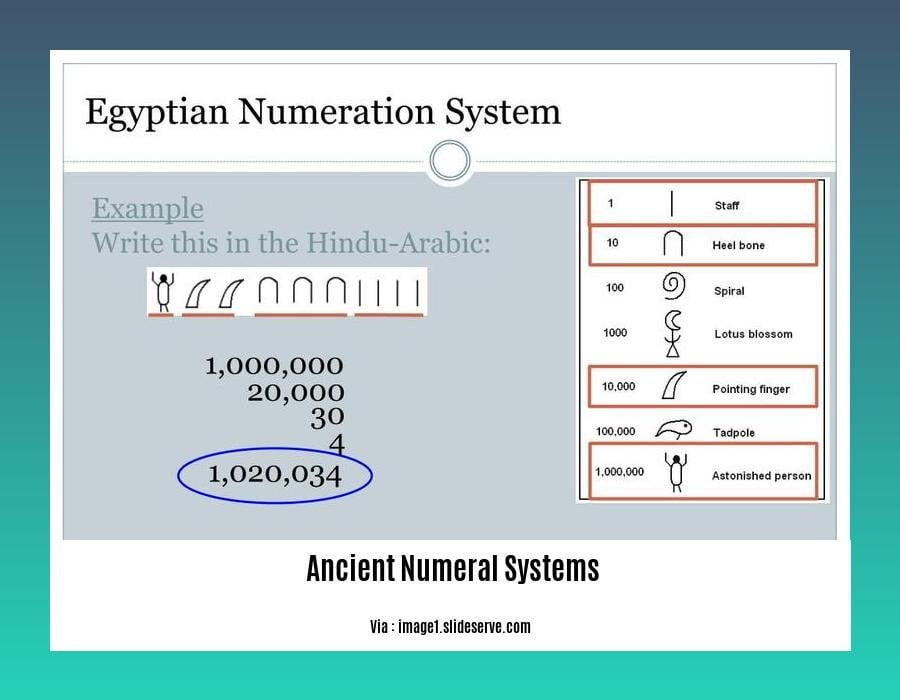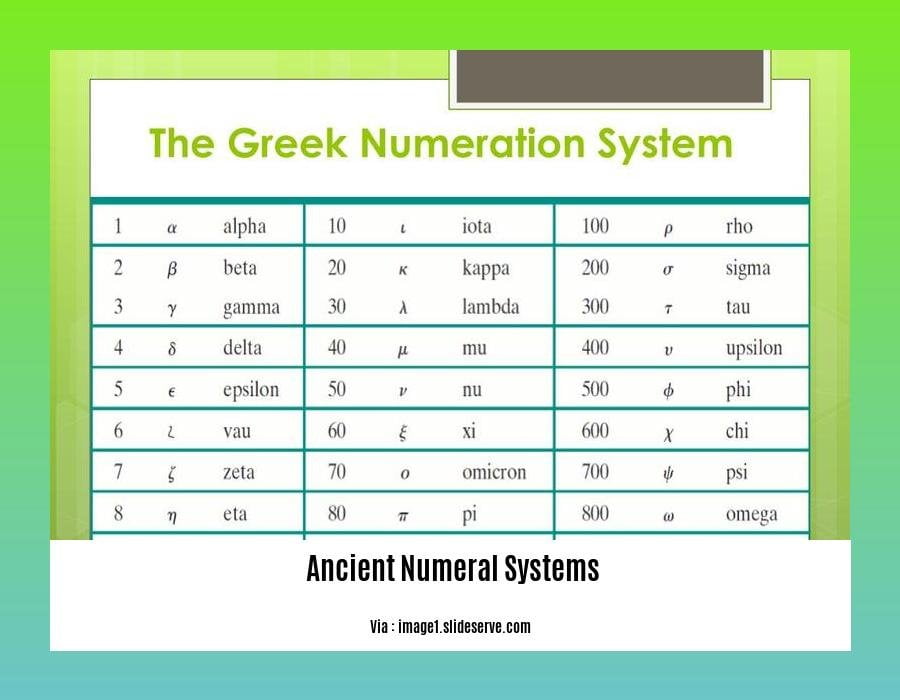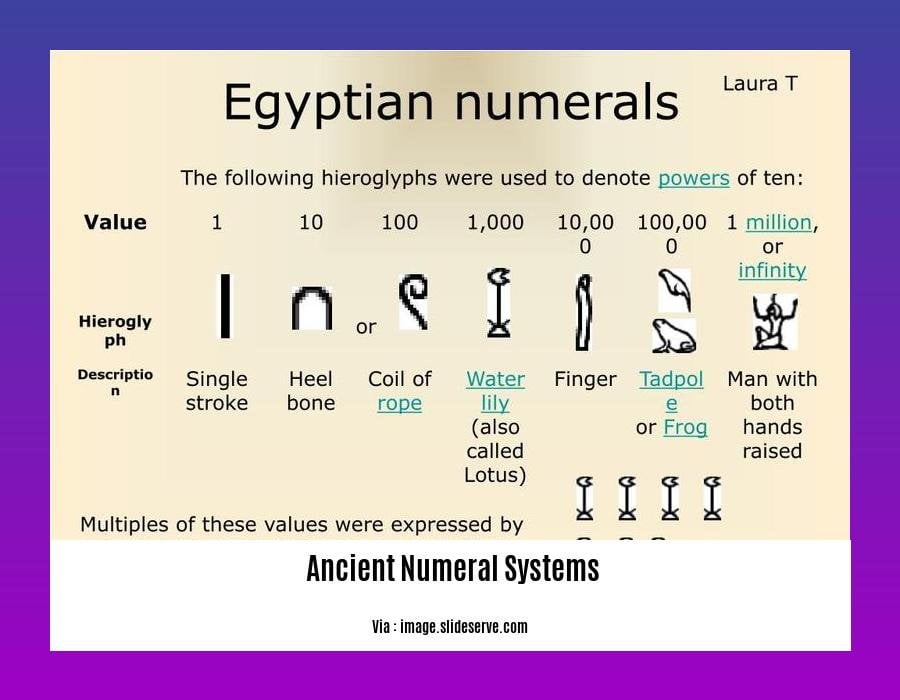Embark on an illuminating journey into [Unveiling the Mysteries of Ancient Numeral Systems: A Historical Exploration]. Prepare to unravel the enigmatic codes employed by ancient civilizations to quantify their world. Together, we will delve into the origins of numerical concepts, deciphering the ingenious methods and symbols that shaped human understanding of mathematics.
Key Takeaways:
- Ancient number systems evolved from tally marks and finger/hand counting (bases 10, 5, 20).
- Clay tokens were the earliest form of written numerals for accounting.
- Roman numerals originated from Etruscan symbols, using vertical marks for 1 and 10, and combinations for larger numbers.
Ancient Numeral Systems

Have you ever wondered how people kept track of numbers before the invention of the Hindu-Arabic numeral system? The answer lies in ancient numeral systems.
Throughout history, different cultures developed unique ways to represent numerical concepts. These systems ranged from simple tally marks to complex symbols, each with its own fascinating story.
The Evolution of Counting
The earliest humans counted using their fingers and toes, leaving tally marks on cave walls or other surfaces to record quantities. These rudimentary systems evolved over time, with people using sticks, pebbles, or other objects as counting tokens.
Clay Tokens and the Birth of Writing
Around 8000 BCE, the Sumerians in Mesopotamia developed a system of clay tokens used for accounting. These tokens had various shapes, each representing a specific quantity. By combining tokens, the Sumerians could record complex numbers. This system is considered the earliest known form of writing, as it allowed for the storage and retrieval of numerical information.
The Rise of Number Symbols
As civilizations advanced, the need for more sophisticated ancient numeral systems arose. The Egyptians developed a hieroglyphic system, where numbers were represented by symbols like the lotus flower (1000) or the frog (100,000). The Babylonians used a base-60 system with cuneiform symbols, which influenced the development of our modern timekeeping system.
The Roman Ingenuity
The Romans developed one of the most recognizable ancient numeral systems. Their system consisted of seven symbols (I, V, X, L, C, D, M), which were combined to represent numbers. For example, the number 49 would be written as XLIX (40 + 9).
The Impact of Ancient Numeral Systems
Ancient numeral systems played a crucial role in the development of human civilization. They enabled people to record complex information, facilitate trade, and advance in mathematics and science. The legacy of these systems can still be seen in our modern number system, timekeeping, and even computer programming.
So, the next time you look at a number, take a moment to appreciate the rich and diverse history that lies behind it. The ancient numeral systems are a testament to the ingenuity and creativity of our ancestors and continue to shape our understanding of the world today.
The development of mathematics, which includes the history of mathematics, development of calculus, and modern mathematical theories, modern-mathematical-theories, is a fascinating topic that spans centuries.
Cross-Cultural Influences and Dissemination

Numeral systems are like cultural fingerprints, shaped by the unique experiences and perspectives of each society. As these cultures interacted and shared ideas, their number systems also influenced each other, creating a rich tapestry of mathematical concepts.
Key Takeaways:
- Cross-cultural exchange: Ancient traders, travelers, and scholars carried their numerical knowledge across borders, leading to the dissemination and adaptation of number systems.
- Shared symbols and principles: Despite their differences, many ancient numeral systems share common symbols and principles, suggesting universal cognitive processes underlying number representation.
- Mathematical innovation: Cultural interactions stimulated mathematical advancements, as ideas from different number systems inspired new approaches to calculations and problem-solving.
Cultural Adaptations:
- Babylonian base-60 system: Influenced timekeeping, astronomy, and later number systems like the Hindu-Arabic system.
- Egyptian hieroglyphic numbers: Adapted to represent larger quantities and decimal fractions, demonstrating the versatility of symbolic systems.
- Roman numerals: Widely used for centuries, showcasing the power of simplicity and practicality in numerical representation.
Enduring Legacy:
Ancient numeral systems continue to shape our world:
- Timekeeping: The Babylonian base-60 system forms the basis of our hours, minutes, and seconds.
- Computer science: Binary numeral systems (base-2) power digital technologies and data processing.
- Number representation: Roman numerals still grace clocks, building numbers, and official documents.
Citation:
- Cultural Variation in Numeration Systems and Their Mapping Onto the Exact Number Concept
- The Cultural Number Line: A Review of Cultural and Linguistic Diversity and Its Impact on Number Cognition
Impact on Mathematical Thought and Scientific Advancements
Ancient numeral systems played a pivotal role in shaping the course of mathematical and scientific thought. By providing a way to represent and manipulate numbers, these systems enabled civilizations to develop sophisticated techniques for calculation, measurement, and problem-solving.
Mathematical Thought
Symbolic Representation:
Numeral systems allowed for numbers to be expressed as symbols, enabling complex mathematical concepts to be recorded and communicated.Quantification:
The ability to quantify physical phenomena, such as distances, time, and quantities of material, led to the development of mathematics as a precise and quantitative discipline.
Scientific Advancements
Measurement and Calculation:
Numeral systems facilitated accurate measurement and calculation, essential for fields such as astronomy, engineering, and surveying.Modeling and Prediction:
The ability to represent and manipulate numbers enabled scientists to create mathematical models and make predictions about natural phenomena.
Key Takeaways:
- Ancient numeral systems provided a foundation for the development of mathematics as a quantitative and precise discipline.
- They enabled the quantification of physical phenomena and facilitated the advancement of scientific knowledge.
- Numeral systems played a crucial role in shaping human civilization’s understanding of the world and its ability to solve complex problems.
Relevant Sources:
- The History of Mathematics
- The Role of Numerals in the Development of Mathematics
Legacy and Enduring Significance
A journey into the past uncovers a rich tapestry of ancient numeral systems that have shaped the course of human history. From humble beginnings to sophisticated numeric frameworks, they played a pivotal role in our ancestors’ lives and continue to resonate with us today.
These systems were not mere abstract concepts but essential tools that unlocked trade, advanced astronomy, and facilitated the construction of architectural marvels. Their legacy endures in the foundations of mathematics, timekeeping, and even computer programming.
The Roots of Number Notation
Early humans relied on intuitive methods like finger counting and tally marks to represent numbers. The Sumerians, around the fourth millennium BCE, developed proto-cuneiform, a wedge-shaped script that laid the groundwork for later numeral systems.
Evolution of Symbols and Notations
Different civilizations devised unique symbolic representations for numbers. The Egyptians employed hieroglyphs, while the Romans developed their iconic numeral system, still widely used today. These symbols transcended language barriers, facilitating communication and fostering cross-cultural exchange.
The Impact of Cultural Influences
Cultural practices and cognitive predispositions influenced the development of numeral systems. The use of hands and feet as counting aids is a common thread across many cultures. This natural connection to our physicality shaped the way people conceptualized and represented numbers.
Key Takeaways:
- Ancient numeral systems played a transformative role in advancing civilization.
- They facilitated trade, commerce, and the development of complex societies.
- These systems continue to influence modern mathematics and technology.
- Cultural factors significantly shaped the evolution of numeral systems.
- The legacy of ancient numeral systems endures in the foundations of modern civilization.
Relevant URL Sources:
- History of Counting Systems and Numerals
- The Earliest Precursor of Writing
FAQ
Q1: What were some of the earliest known methods for representing numbers in ancient civilizations?
Q2: How did cultural factors influence the development of ancient numeral systems?
Q3: What are some of the key mathematical principles and symbols used in ancient numeral systems?
Q4: How did the evolution of numeral systems impact the development of mathematics and science in ancient civilizations?
Q5: What can ancient numeral systems tell us about the cognitive processes and cultural practices of ancient peoples?
- China II Review: Delicious Food & Speedy Service - April 17, 2025
- Understand Virginia’s Flag: History & Debate - April 17, 2025
- Explore Long Island’s Map: Unique Regions & Insights - April 17, 2025


![[History of Accounting SS1]: A Journey Through the Evolution of Financial Practices history-of-accounting-ss1_2](https://www.lolaapp.com/wp-content/uploads/2023/12/history-of-accounting-ss1_2-150x150.jpg)













